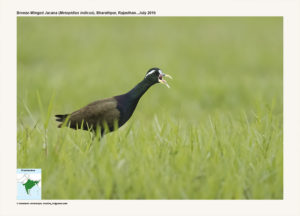Bronzed-winged Jacana

Bronzed-winged Jacana Metopidius ardeola
Etymology:
- Metopidius : Greek word for on the forehead derived from metopon – forehead, brow
- Ardeola : Latin word for heron derived from ardea- heron
Vernacular Names : Hindi: Jal pipi, Sans: Jalkapot, Bi: Pipi, Kundai, Kattoi, Ben: Dal pipi, Jal pipi, Karatiya, Ass: Dol punga, Cachar: Pipi, Mani: Thamnachenbi, Guj: Kalo jal manjar, Mar: Neelkamal, Soneri pankhacha/ Kansya Pankhi kamalpakshi, Ta: Thamara kozhi, Te: Kanchurekkalu jacana, Kan: Kenchu rekkeya neeru gili
Distribution in India: Widespread resident except North West and Himalayas.
Description: Size: 38-41 cm. It has a glossy, black plumage. Its back, scapulars and upperwing-coverts are greenish. Its tail and vent are rufous; bill is greenish-yellow with yellow tip and red base, lappets and small frontal shield bluish, becoming all bright red during courtship; conspicuous white stripe extends from eye to nape; cornified carpal knob. The female is similar to male, but larger especially in mass, bill length, wing length, tarsus length and shield height.
Habitat:It is found in freshwater lakes, swamps, tanks, ponds, etc., especially in plains and in plateau country; also occurs in denser vegetation, wet grasslands, and overgrown paddy fields.
Food Habits: It eats insects and other invertebrates picked from the floating vegetation or the water’s surface. Also eats shoots and bulbs of water plants
Breeding Habits: They breed in July-Sept in India .They are polyandrous; males vigorously defend territories against other males, females defend their mates’ territories against other females. The degree of polyandry depends on both male and female territory sizes, with females generally mating with 1–4 different males, larger females securing more mates and producing more clutches, and males in larger harems defending smaller territories, but larger males generally defend larger territories. The nest is made of aquatic vegetation, on water-lily leaves or in emergent grasses, placed in dense vegetation .Both sexes toss potential nest material. Each male commonly constructs up to five different nests. They lay a clutch of 3–4 eggs. The incubation period is 26–29 days. The male alone incubates eggs and cares for chicks. The male defends chicks aggressively, and in this is assisted by female; young become independent after they are 70 days old.